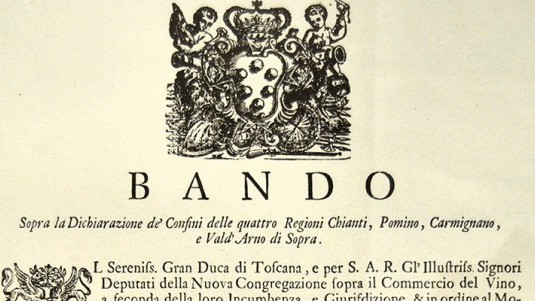Cosimo III and his descendants

Reading the famous 1716 edict with which the Grand Duke of Tuscany Cosimo III de Medici delimited the areas and regulatied the production of wine in Chianti, Carmignano, Pomino and Val di Sopra, what stands out most is how modern and efficient the regulations were. In order to draft it and ensure its application, he sought the collaboration of the leading aristocratic landowners of the time, those whose names are still well-known today for being important wine producers: Antinori, Corsini, Ricasoli and Albizzi, who then married into the Frescobaldi family. They all had great experience and helped Cosimi with a task that was by no means easy. All this was recalled by Professor Zeffiro Ciuffoletti, of Florence’s Georgofili Academy, during a debate held a few weeks ago in Palazzo Vecchio’s Sala del Cinquecento. The forum was organized by various producer associations in the four zones which are more or less the same as they were demarked 300 years ago. It was an interesting and well-organized event but one which saw the total absence of any representative from the local or central government. “If we had been in France today would have been a national holiday,” was the polemic remark of Luca Sanjust, the president of the Valdarno di Sopra producers’ association. Maybe that was an exaggeration but for sure the French minister for agriculture would not have limited himself to sending a taped video message and not even send an undersecretary the way the Italian one did. And so once again and despite its historic importance (the edict was the first modern regulatory measure for production), wine was used by Italy’s government officials as something to fill their mouths with, not to drink but to make speeches that were not really pertinent, highlighting words like “excellence” and “export”, subjects they have done little if anything to foster. But then for the world or wine, politics is like rain.
It’s okay if there is not enough but too much ruins everything. Cosimo III understood this well and his regulations were drawn up by experts and not spin doctors. But then back in those days ideas were already circulating that would eventually lead to the Enlightenment. Among those at the forum was the Italian representative for Alibaba, the Chinese online e-commerce group with whom Premier Matteo Renzi (who did make a brief appearance at the conference) stipulated an accord for the sale of Italian wine in China. “It was a good thing,” the representative said, “it’s too bad Chinese consumers know nothing about Italian wine”. To resolve this a task force could be set up that could explain Italian wine, in Chinese or at least in English, by organizing seminars or promotional initiatives even during the many trade fairs that are flourishing in China today. State broadcaster Rai International could produce educational programs on PDO products in various languages to be sold to TV stations around the world. Or Italy’s foreign Trade Institute ICE could invite to Italy, involving producer associations, leading Chinese economic figures and journalists for educative tours. These are all initiatives that French governments consider routine seeing how many they support. All this in Italy is not on the horizon or, as far as I can see, even on the drawing board. And so Italy yet again lags behind. The catchphrase ‘work as a team’ is just an illusion and wine producers, as always, have to go it alone on foreign markets. Yet despite all this Italy is the greatest wine exporter in terms of quantity in the world. Just image what would happen if it ever got organized.

 Italiano
Italiano







